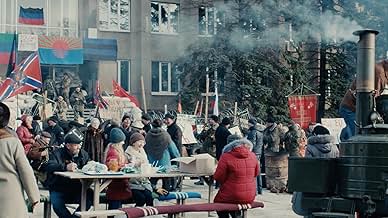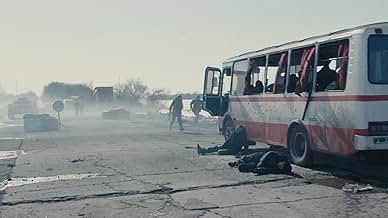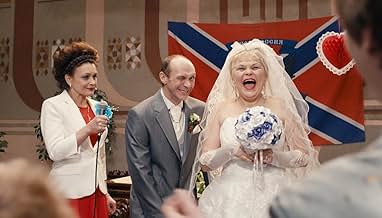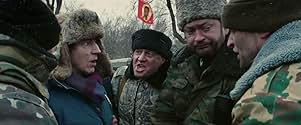Donbass
- 2018
- 2 घं 2 मि
IMDb रेटिंग
6.6/10
5.1 हज़ार
आपकी रेटिंग
अपनी भाषा में प्लॉट जोड़ेंIn eastern Ukraine, society begins to degrade as the effects of propaganda and manipulation begin to surface in this post-truth era.In eastern Ukraine, society begins to degrade as the effects of propaganda and manipulation begin to surface in this post-truth era.In eastern Ukraine, society begins to degrade as the effects of propaganda and manipulation begin to surface in this post-truth era.
- पुरस्कार
- 9 जीत और कुल 14 नामांकन
Olesya Zhurakivska
- Girl with bucket
- (as Olesya Zhurakovskaya)
फ़ीचर्ड समीक्षाएं
This film was sponsored and financed by various organizations in the Ukraine and European countries, so one expects (and gets) a generally uncomplimentary picture of the people of the breakaway Donbass region of Ukraine. However, the picture is not one-sided; for instance, we are shown people living in crowded, unsanitary cellars to escape the constant, unpredictable Ukrainian shelling of Donbass cities and towns, with no military objectives and plenty of civilian casualties.
The question is: what is real and what is staged or reenacted? Some sequences (such as the wedding) may have been shot from reality, perhaps with some rehearsal, but others are clearly staged, such as that where a prisoner Ukrainian soldier is abused and insulted by a crowd. The framing of the shots is careful and deliberate, and the prisoner, as many other characters in the movie is played by a professional actor. Finally, one episode is clearly trying to depict the banditry and brutality of the Donbass militia, so one could hardly expect the militants to appear voluntarily in front of the camera in an unfavorable light.
Perhaps the key to the film is given by Ukrainian director Sergey Loztnitsa in the first episode, where a crew of actors is seen staging and playing a bombing incident for the camera (the same crew is attacked in the end but we are never sure if the violence is real or staged). Perhaps Loznitsa is trying to warn the viewer to take the proceedings with a grain of salt. The Donbass is referred to in the movie as "separatist" and as an "occupied territory" of the Ukraine. The first is correct but the second arguable: no occupiers are in sight. All in all an incomplete but fascinating view of the Donbass and its people in the period preceding the present war, although watchers should exercise their critical sense.
The question is: what is real and what is staged or reenacted? Some sequences (such as the wedding) may have been shot from reality, perhaps with some rehearsal, but others are clearly staged, such as that where a prisoner Ukrainian soldier is abused and insulted by a crowd. The framing of the shots is careful and deliberate, and the prisoner, as many other characters in the movie is played by a professional actor. Finally, one episode is clearly trying to depict the banditry and brutality of the Donbass militia, so one could hardly expect the militants to appear voluntarily in front of the camera in an unfavorable light.
Perhaps the key to the film is given by Ukrainian director Sergey Loztnitsa in the first episode, where a crew of actors is seen staging and playing a bombing incident for the camera (the same crew is attacked in the end but we are never sure if the violence is real or staged). Perhaps Loznitsa is trying to warn the viewer to take the proceedings with a grain of salt. The Donbass is referred to in the movie as "separatist" and as an "occupied territory" of the Ukraine. The first is correct but the second arguable: no occupiers are in sight. All in all an incomplete but fascinating view of the Donbass and its people in the period preceding the present war, although watchers should exercise their critical sense.
This film was made four years ago, but the war in Ukraine has given it a new urgency. At the time of its original release, the conflict in eastern Ukraine was not high on the world's priority list. Because of the Russian agression, this film has been released again. A good thing, because not only the current affairs are a reason to go see this movie. It is a very good film in its own right.
It consists of short vignettes, loosely related, some surreal, some very shocking, and some even funny. The central theme in each of them is the absurdity of the situation in the Donbass region. I write situation, because what the film shows is not an outright war. Corruption, abuse of power and lawlessness are as much a problem as violence.
Sometimes the scenes are reminiscent of the films by Roy Andersson, the Swedish master of minimalist absurdism. But there are also Fellini-like situations, with over-the-top characters contrasting the bleak reality of every day life in an occupied territory. Apart from the originality, two other things really stand out: the acting and the cinematography. Some of the scenes look like mini-documentaries, not at all like scripted movie scenes. Romanian cinematographer Oleg Mutu shows how effective very long takes can be, sometimes with a camera on the shoulder, sometimes without any camera movement. The very last scene consists of one single, extended shot. It is a master class in understated film making.
It consists of short vignettes, loosely related, some surreal, some very shocking, and some even funny. The central theme in each of them is the absurdity of the situation in the Donbass region. I write situation, because what the film shows is not an outright war. Corruption, abuse of power and lawlessness are as much a problem as violence.
Sometimes the scenes are reminiscent of the films by Roy Andersson, the Swedish master of minimalist absurdism. But there are also Fellini-like situations, with over-the-top characters contrasting the bleak reality of every day life in an occupied territory. Apart from the originality, two other things really stand out: the acting and the cinematography. Some of the scenes look like mini-documentaries, not at all like scripted movie scenes. Romanian cinematographer Oleg Mutu shows how effective very long takes can be, sometimes with a camera on the shoulder, sometimes without any camera movement. The very last scene consists of one single, extended shot. It is a master class in understated film making.
"What have you got for me?!" asks a soldier at a checkpoint in Eastern Ukraine. Not getting a lot of traction with locals on a bus who are obviously affected by the fighting and not well off, he seems genuinely pleased with the offering of a bit of lard to chew on. "Extermination squad volunteer" are the words pinned to a man as he is paraded around town by a Russian separatist soldier, berated and beaten by local citizens.
Such stranger than fiction material from occupied Ukraine is the subject of an unconventional, unsettling and darkly humorous documentary. Film scenes are recreated from episodes gleaned from YouTube and other media. Get a front row seat to strange and disturbing scenes including bribery, confiscation, artillery barrages, the Lady MacBeth of Russian separatists, and more.
Donbass is raw, revealing and powerful. No one can cover their eyes to what is going on in Donbass, which is nothing less than the recolonization of former Russian territory. People are virtually powerless and they bear the brunt of the fighting. Fire and violence tend to invite more of the same. 26 professional actors were employed, and the rest are locals, according to the director who was at this North American premiere at the 2018 Toronto International Film Festival.
Such stranger than fiction material from occupied Ukraine is the subject of an unconventional, unsettling and darkly humorous documentary. Film scenes are recreated from episodes gleaned from YouTube and other media. Get a front row seat to strange and disturbing scenes including bribery, confiscation, artillery barrages, the Lady MacBeth of Russian separatists, and more.
Donbass is raw, revealing and powerful. No one can cover their eyes to what is going on in Donbass, which is nothing less than the recolonization of former Russian territory. People are virtually powerless and they bear the brunt of the fighting. Fire and violence tend to invite more of the same. 26 professional actors were employed, and the rest are locals, according to the director who was at this North American premiere at the 2018 Toronto International Film Festival.
A mix of Kusturica and Fellini, describing the East Ukraine in dark, cold, ironic, cruel, carnaval - like colors. A film about cynismus, propaganda, manipulation, terror, nationalism, cruelty and apparences but, more important, about people as victima of whole situation. Maybe, a manifesto.
This movie is a sequence of barely connected vignettes about life in Russian-occupied east of Ukraine, and just how horrific and grotesque it is to live there at the moment. It captures all of the details flawlessly - it sometimes is shot for shot live-action version of existing videos on Youtube, but with real actors. Donbass is depressing as hell but so is the existence in that region, so it is well deserving of many awards that this movie received.
क्या आपको पता है
- ट्रिवियाOfficial submission of Ukraine for the 'Best Foreign Language Film' category of the 91st Academy Awards in 2019.
- कनेक्शनReferenced in Radio Dolin: Sergei Loznitsa (2022)
- साउंडट्रैकThe National Anthem of Ukraine
Lyrics by Pavlo Chubynsky
Music by Mikhailo Verbytsky
Performed by The Veryovka National Academic Ukrainian Folk Choir
टॉप पसंद
रेटिंग देने के लिए साइन-इन करें और वैयक्तिकृत सुझावों के लिए वॉचलिस्ट करें
- How long is Donbass?Alexa द्वारा संचालित
विवरण
- रिलीज़ की तारीख़
- कंट्री ऑफ़ ओरिजिन
- आधिकारिक साइट
- भाषाएं
- इस रूप में भी जाना जाता है
- Донбас
- फ़िल्माने की जगहें
- उत्पादन कंपनियां
- IMDbPro पर और कंपनी क्रेडिट देखें
बॉक्स ऑफ़िस
- दुनिया भर में सकल
- $1,41,067
- चलने की अवधि
- 2 घं 2 मि(122 min)
- रंग
- पक्ष अनुपात
- 2.35 : 1
इस पेज में योगदान दें
किसी बदलाव का सुझाव दें या अनुपलब्ध कॉन्टेंट जोड़ें

![Trailer [OV] देखें](https://m.media-amazon.com/images/M/MV5BZDBjMTdhZDYtOWI4NS00NmYwLWExYjgtY2VmYzQxYzlkNDhmXkEyXkFqcGdeQXRyYW5zY29kZS13b3JrZmxvdw@@._V1_QL75_UX500_CR0)
























